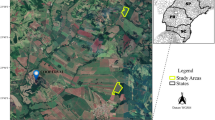Abstract
A field-based study was carried out to broaden our knowledge of fully mechanized cut-to-length harvesting productivity in naturally grown forests in the northern European part of Russia (NEPR). The recorded data comprised 38 midsized single-grip harvesters (JD 1270D) in clear-cutting operations in the Karelia, Komi, Vologda, Leningrad, Tver, and Kirov regions in NEPR, 4.3 million felled trees, and 1.4 million m3 u.b. (under bark) of processed timber. Harvesting operations were conducted in forest stands composed of spruce (48% on average), pine (19%), birch (22%), and aspen (11%), with an average stem volume 0.31 m3 u.b. The cut-to-length harvesters produced from 4.3 to 14.9 m3 u.b./productive machine hour (PMH) and 16.0–49.5 m3 u.b./stem processing machine hour (S proc MH). A machine evaluation analysis and a regression analysis were used to formulate models for predicting cutting productivity of modern single-grip harvester. The regression models were developed to estimate the productivity of the harvesters in the regions taking into account two significant factors influencing the productivity: the stem volume and tree species of the felled trees. Productivity/cubic meter u.b. of processed timber/PMH was calculated according to stem volume and tree species distributions in most forest-covered NEPR regions. Further research is suggested to improve the developed productivity models and to allow prediction of system performance over a broad range of stand and site conditions.





Similar content being viewed by others
References
Adebayo AB, Han HS, Johnson L (2007) Productivity and cost of cut-to-length and whole-tree harvesting in a mixed-conifer stand. For Prod J 57(5):59–69
Asikainen A, Leskinen L, Pasanen K, Väätäinen K, Anttila A, Tahvanainen T (2009) Metsäkonesektorin nykytila ja tulevaisuus. Today and the future of the forest machine sector. Metla Work Pap 125:48 (in Finnish)
Bulley B (1999) Effect of tree size and stand density on harvester and forwarder productivity in commercial thinning. FERIC technical note TN-292, July 1999
Gellerstedt S, Dahlin B (1999) Cut-to-length in the next decade. J For Eng 10(2):17–25
Gerasimov Y (2004) Cut-to-length method in the wood procurement of Russia: SWOT analysis. In: Proceedings of the NSR conference in forest operations 2004. Silva Carelica 45:338–344
Gerasimov Y, Seliverstov A (2010) Industrial round-wood losses associated with the harvesting systems in Russia. Croat J For Eng 31(2):111–126
Gerasimov Y, Sokolov A (2008) GIS-based decision-support program for planning and analyzing short-wood transport in Russia. Croat J For Eng 29(2):163–175
Gerasimov Y, Sibiryakov K, Moshkov S, Välkky E, Karvinen S (2009) Cost calculation of timber harvesting machines. Metsäntutkimuslaitos, Joensuu, p 44 (in Russian)
Gingras JF (1994) A comparison of full-tree versus cut-to-length systems in the Manitoba model forest. SR-92. Forest Engineering Institute of Canada, Quebec, p 16
Jiroušek R, Klvač R, Skoupy A (2007) Productivity and costs of the mechanised cut-to-length wood harvesting system in clear-felling operations. J For Sci 53(10):476–482
Kärhä K, Rönkkö E, Gumse S (2004) Productivity and cutting costs of thinning harvesters. J For Eng 15(2):43–56
Kariniemi A (2006) Kuljettajakeskeinen hakkuukonetyön malli: työn suorituksen kognitiivinen tarkastelu. Operator-specific model for mechanical harvesting: cognitive approach to work performance. Doctoral dissertation. Helsingin yliopiston metsävarojen käytön latoksen jukaisuja, vol 38, p 126
Kuitto PJ, Keskinen S, Lindroos J, Oijala T, Rajamäki J, Räsänen T, Terävä J (1994) Puutavaran koneellinen hakku ja metsäkuljetus. Metsätehon tiedotus, vol 410, p 38
Lageson H (1997) Effects of thinning type on the harvester productivity and on the residual stand. J For Eng 8(2):7–13
Makkonen I (1991) Silver streak single-grip harvester in Nova Scotia. FERRIC, Pointe Claire. Field note no. TR-94, p 18
McNeel JF, Rutherford D (1994) Modelling harvester-forwarder system performance in a selection harvest. J For Eng 6(1):7–14
Nurminen T, Korpunen H, Uusitalo J (2006) Time consumption analysis of the mechanized cut-to-length harvesting system. Silva Fennica 40(2):335–363
Puttock D, Spinelli R, Hartsough BR (2005) Operational trials of cut-to-length harvesting of poplar in a mixed wood stand. J For Eng 16(2):17–25
Richardson R (1989) Evaluation of five processors and harvesters. Forestry Engineering Research Institute of Canada, Pointe Claire. Technical report no. TR-94:18
Ryynänen S, Rönkkö E (2001) Harvennusharvestereiden tuottavuus ja kustannukset. Helsinki. Työtehoseuran julkaisuja, vol 381, p 67
Sirén M (1998) Hakkuukonetyö, sen korjuujälki ja puustovaurioiden ennustaminen. Väitöskirja. Metsäntutkimuslaitoksen tiedonantoja, vol 694, p 179
Sirén M, Aaltio H (2003) Productivity of costs of thinning harvesters and harvester-forwarders. Int J For Eng 14(1):39–48
Spinelli R, Owende PMO, Ward S (2002) Productivity and cost of CTL harvesting of E. globulus stands using excavator-based harvesters. For Prod J 52:67–77
Statistical Year Book of Finnish Forestry (2009)
Syunev VS, Sokolov AP, Konovalov AP, Katarov VK, Seliverstov AA, Gerasimov YY, Karvinen S, Valkky E (2009) Comparison of wood harvesting methods in logging companies of the Republic of Karelia. Working papers of the Finnish Forest Research Institute, vol 120, p 117
Väätäinen K, Ovaskainen H, Ranta P, Ala-Fossi A (2005) Hakkuukoneenkuljettajan hiljaisen tiedon merkitys hakkuutulokseen työpistetasolla. Metsäntutkimuslaitoksen tiedonantoja, vol 937, p 90
Väätäinen K, Liiri H, Asikainen A, Sikanen L, Jylhä P, Rieppo K, Nuutinen Y, Ala-Fossi A (2007) Korjureiden ja korjuuketjun simulointi ainespuun korjuussa. Metlan työraportteja, vol 48, p 78
Ward SM (2002) Productivity and cost of CTL harvesting of eucalyptus globulus stands using excavator-based harvesters. For Prod J 52(1):67–77
Yaoxiang L, Wang J, Miller G, McNeel J (2006) Production economics of harvesting small-diameter hardwood stands in central Appalachia. For Prod J 56(3):81–86
Acknowledgments
The publication was prepared for the project “Wood Harvesting and Logistics,” financed by the European Union through the Finnish Funding Agency for Technology and Innovation (TEKES).
Author information
Authors and Affiliations
Corresponding author
Additional information
Communicated by W. Warkotsch.
Rights and permissions
About this article
Cite this article
Gerasimov, Y., Senkin, V. & Väätäinen, K. Productivity of single-grip harvesters in clear-cutting operations in the northern European part of Russia. Eur J Forest Res 131, 647–654 (2012). https://doi.org/10.1007/s10342-011-0538-9
Received:
Revised:
Accepted:
Published:
Issue Date:
DOI: https://doi.org/10.1007/s10342-011-0538-9




